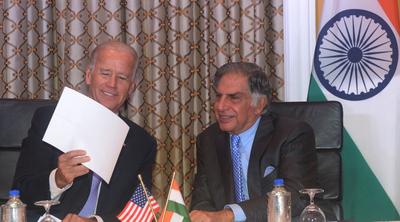In the current visit, VP Biden met with his counterpart Hamid Ansari as well as Prime Minister Manmohan Singh and President Pranab Mukherjee. The emphasis was on political, security and economic/trade related matters. The last area was the focus of the Mumbai leg of Biden’s visit where he met with corporate India.
The essence of the Biden message is contained in his remarks in Mumbai where he noted: ‘I would ask you to consider the historic opportunity that we have here … imagine what our two countries can achieve together, not only for one another but for the economic and political stability of the region’.
Despite the dramatic rearrangement of the bilateral relationship in late 2008 under the Bush–Singh stewardship (when the estrangement over the nuclear issue was consensually resolved), India–US ties have been adrift due to a combination of circumstances — primarily the global economic downturn since 2009 and the deteriorating economic and fiscal health of both countries, and the related preoccupation of the political leadership with their domestic priorities.
Against this backdrop, the Biden visit is welcome and provides an opportunity to both review bilateral ties and hit the reset button. While the United States has its heavyweight political representatives who were committed to the India relationship (for instance, Condoleezza Rice, Hillary Clinton and now Joe Biden) it is difficult to identify a similar array in the fragmented Indian political leadership.
The 2008 civilian nuclear agreement was realised in an almost furtive and apologetic manner on the Indian side, and it is to Prime Minister Singh’s credit that he stood his ground and was willing to stake his office on staying the course. Regrettably, major political actors have chosen to remain ambiguous about how they wish to take the bilateral relationship forward, and have left it to the bureaucracy and the corporate leaders to define the contours of the relationship. Where political leaders have taken a position, it has been more in the neti neti (Sanskrit for ‘not this, not that’) mode and have played up to the gallery in stoking latent anxiety about the purported nefarious and overbearing US design to inveigle or exploit India. This has been most evident in the defence and security domain where there is opaque diffidence instead of objective clarity about how to maximise the relationship post 2008.
In short, there is no Biden equivalent in the Indian political spectrum, and Prime Minister Singh is too beleaguered and lacks the political support he needs to pursue certain long-term strategic objectives. India is currently preparing for its next general election, and the received wisdom is that an uneasy coalition will form the next government in Delhi. Regional parties are likely to play a critical role in forming government, and hence there is need for deep introspection by this leadership about how India’s long-term strategic and security interests will be served through the US relationship.
The Biden visit drew attention to the economic and trade dimension and highlighted the fact that very soon India will reach a $100 billion trade figure with America, and this will be comparable to that with China, both in quantum and imbalance. Yes, there are areas of divergence whether related to the WTO, protectionism, intellectual property rights, lack of market access, visa protocols and foreign investment regulation among others, but this is to be expected. However, market forces, officials and corporate professionals on both sides are engaged in finding a way forward.
Regrettably, this is not the case when it comes to the security and strategic domain. Here again there are major divergences, particularly with respect to Pakistan, Afghanistan and Iran in the immediate context. China is a case of both sides hedging their options, though the fact that Delhi was trying to deal with the latest Chinese army incursion during the Biden visit has its own sub-text.
The Indian security apex has to evolve a long-term blueprint, with appropriate political backing, that is bipartisan about how to engage equitably with both the United States and China and manage this complex triangular relationship in such manner that legitimate national aspirations are realised, while deep-seated anxieties are assuaged or effectively quarantined.
Biden’s observation that ‘[t]here is no contradiction between strategic autonomy and a strategic partnership … Global powers are capable of both’ merits careful review and consideration for its policy implications by the Indian polity.
C Uday Bhaskar is Distinguished Fellow at the Society for Policy Studies, New Delhi
A version of this article was originally published here at The Asian Age.

